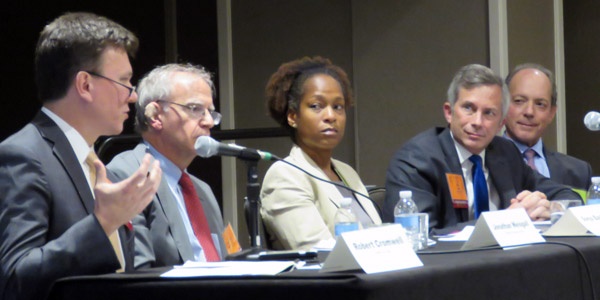By Rich Heidorn Jr.
WASHINGTON — Seattle officials Monday deferred action on a proposal by the city-owned utility to join the Western Energy Imbalance Market. Seattle City Light could become the sixth utility to join the CAISO-run EIM, following recent additions Arizona Public Service and Puget Sound Energy, which began EIM operations Oct. 1, and Portland General Electric, which is scheduled to join in 2017. (See related story, Smooth EIM Transition for Arizona Public Service, Puget Sound Energy.)
An official of the Seattle utility joined several other Western energy leaders at the Energy Bar Association’s Mid-Year Energy Forum last week to discuss the growth of the EIM, “Caliphopia” and how the Western Interconnection is likely to change.

Cromwell | © RTO Insider
To Robert W. Cromwell Jr., director of regional affairs and contracts for Seattle City Light, the math of joining the EIM is a no-brainer. Cromwell said it will cost the city $8.8 million to join the EIM and $2.8 million a year in operating costs. The payoff? An estimated $4 million to $23 million in annual savings through arbitrage opportunities by “capturing low prices to serve load [and] high prices to sell surplus energy.”
Cromwell said the utility differs from other public power companies because its large hydropower facilities on the Skagit and Pend Oreille rivers “force us to sell into the market.”
He said the utility also is pressured by declining wholesale revenue — a trend likely to worsen as growing wind and solar power create more frequent periods of zero and negative pricing — and declining retail loads. “I’ve got about 60 tall cranes [constructing] very large buildings in my city and my load went down,” he said.
On Monday, the Seattle City Council delayed a vote on the EIM initiative for three weeks. The bill would allow City Light to enter an exploratory phase for joining the EIM, but some council members were concerned about the costs of doing even that.

Weisgall © RTO Insider
Jonathan M. Weisgall, vice president of legislative and regulatory affairs for Berkshire Hathaway Energy, also sees the advantages of regionalization as undeniable. Pointing to a map showing the 38 balancing authorities in the Western Interconnection, he joked, “To call this Balkanized is to insult Macedonia.”
Bilateral trading with manual dispatch and little situational awareness of other BAs is like using Craigslist, he said. The EIM, he said, is like “Match.com for electrons,” with five-minute dispatch, which is more accommodating for renewable generation.
Berkshire Hathaway’s NV Energy and PacifiCorp have saved $60 million since joining the EIM — a 20-month information technology project, Weisgall said, that required no new physical infrastructure.
‘Caliphobia’

Not everyone is rushing to join CAISO’s expansion, of course. For some, any sentence containing the words “California” and “energy” sends shivers. It’s not just the state’s liberalism but also memories of the 2000 energy crisis and Enron, which purchased Portland General Electric before imploding following disclosures of accounting and power trading frauds.
“The Northwest didn’t forget. Memories are long up there,” said Jonathan D. Schneider, of Stinson Leonard Street, who moderated the discussion.
Weisgall acknowledged that what he called “Caliphobia” is a challenge to a West-wide RTO.
“You’re trying to marry three incredibly blue states — California, Oregon and Washington — where it’s almost a felony to produce coal — with three very red states — Wyoming, Idaho, Utah — states that do not care about getting to 50% renewables much less … about greenhouse gas emission programs,” he said. “That makes it very, very tough.”
“We should not underestimate the challenge of getting there,” agreed Kenneth G. Jaffe, a partner with Alston & Bird, who represents CAISO.

Left to Right: Cromwell, Weisgall, Baskerville, Jaffe and Schneider | © RTO Insider
“There are a large number of public power brethren in the Northwest who simply will not join a centrally cleared market before they die,” agreed Cromwell.
He noted efforts by Xcel Energy and others to create a Day 2 market in the Front Range in central Colorado and southeastern Wyoming, which he predicted will be operated by SPP or MISO. “The Cal-ISO isn’t the only game in town. (See “Xcel Seeking Larger Dispatch Areas in the West,” Overheard at the Transmission Summit.)
BPA’s View

In addition to the political challenges and governance questions, another obstacle to an RTO West has been the Pacific Northwest’s bounty of rivers. Cheap hydropower represents about half of the power generation in the Northwest.
That’s “one of the reasons why a standalone market in the Northwest hasn’t penciled out the way it would in a somewhat more diverse resource base as is so in the east,” Schneider said.
“If you’ve got a local public utility district and your embedded costs of delivering power is about 2 cents/kWh … [any change] is a cost adder,” agreed Cromwell.
Nevertheless, the Bonneville Power Administration has been seeking ways to collaborate with CAISO, said Sonya Baskerville, manager of BPA’s national relations office. The agency is concerned with serving BPA load located within BAs that have joined the EIM as well ensuring it has outlets for marketing surplus energy.
“We can’t just sit by and let things roll on without being a player in that. We are having active conversations with the Cal-ISO, with other utilities in our region to talk about our primary goal, which is to preserve the value of our system — both hydro and our federal transmission system,” she said.
Central to any agreement would be a governance structure that preserves BPA’s financial and operational interests, Baskerville said.
“In the Northwest, we like to have control over our own destiny,” she said. Previous regionalization efforts “have failed because [of] that one issue.” (See related story, Latest CAISO Proposal Fills out Western RTO Governance Plan.)
— Robert Mullin contributed to this article.



